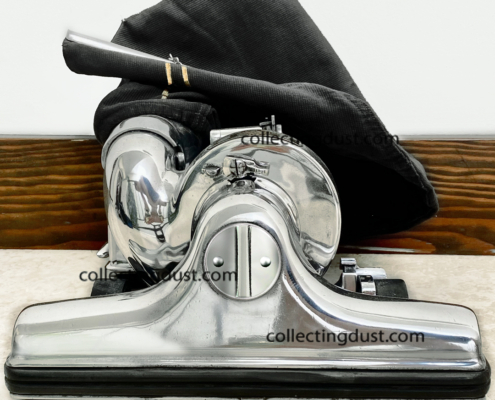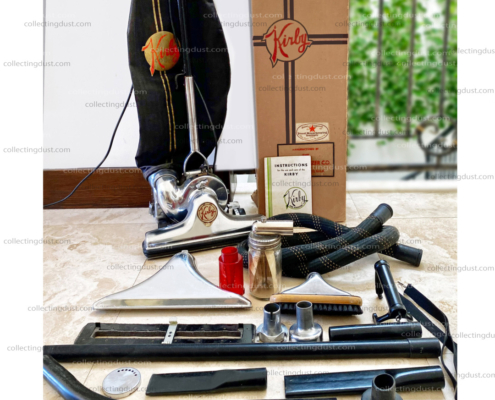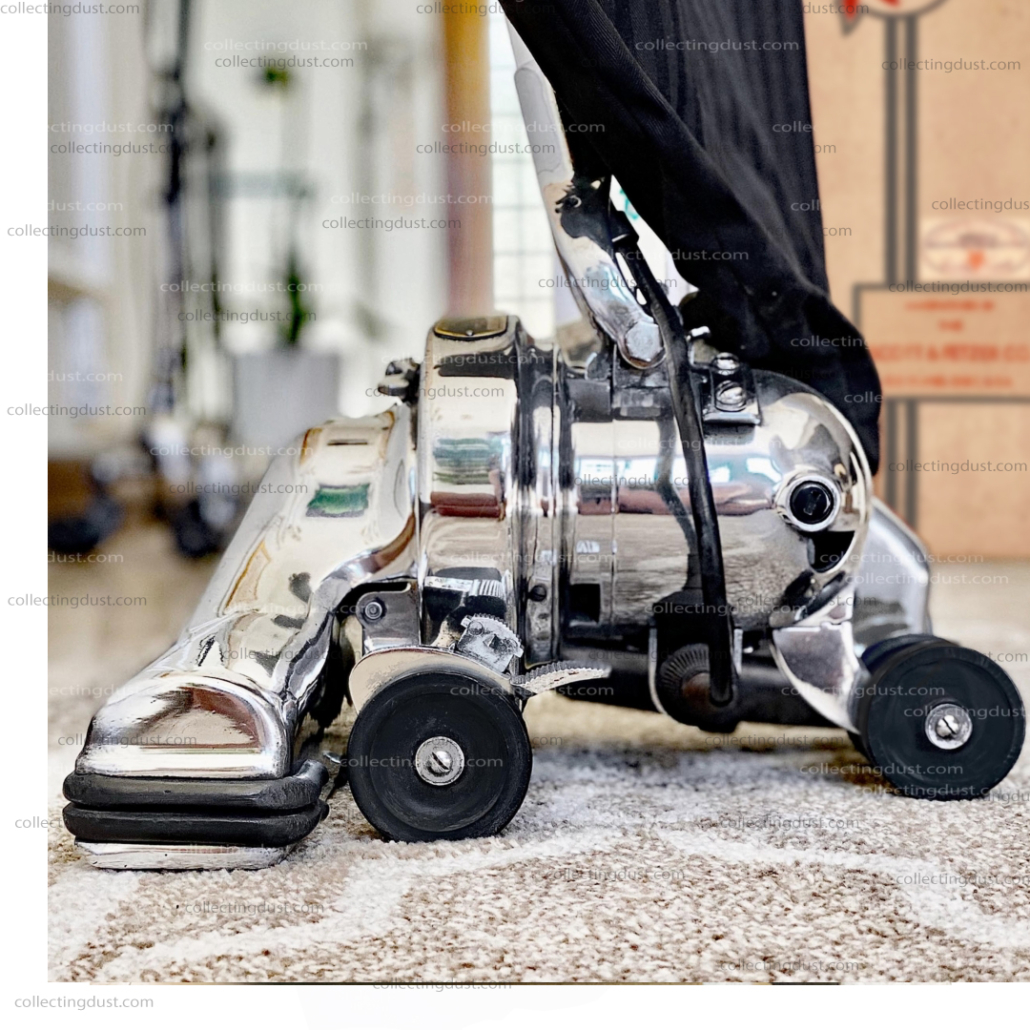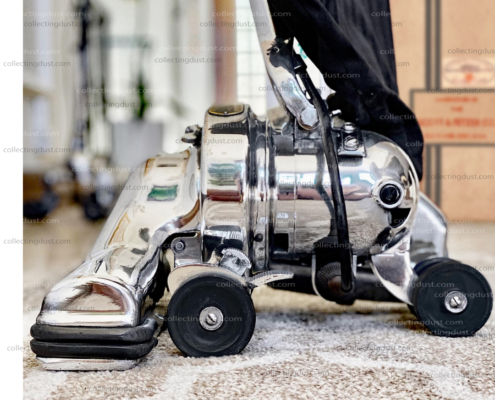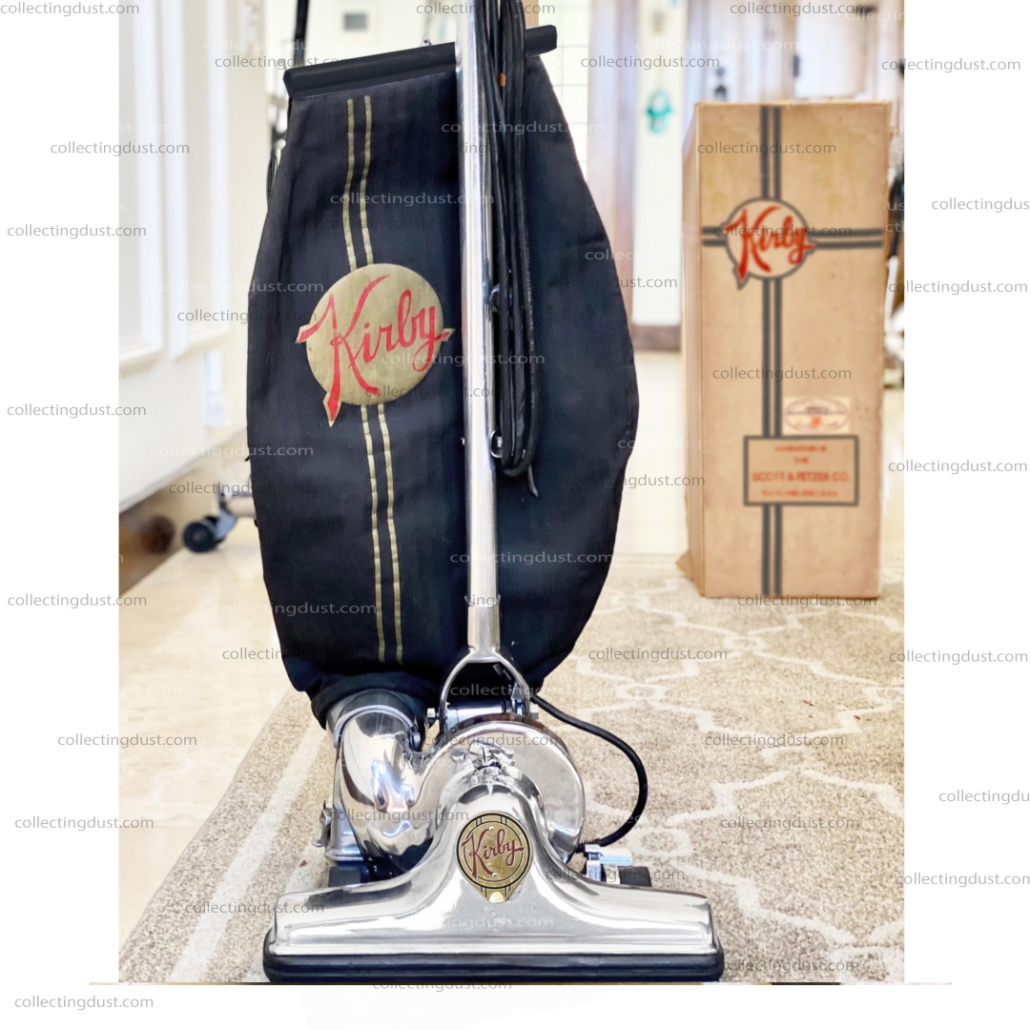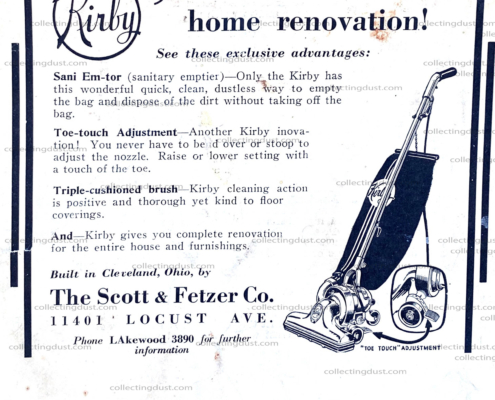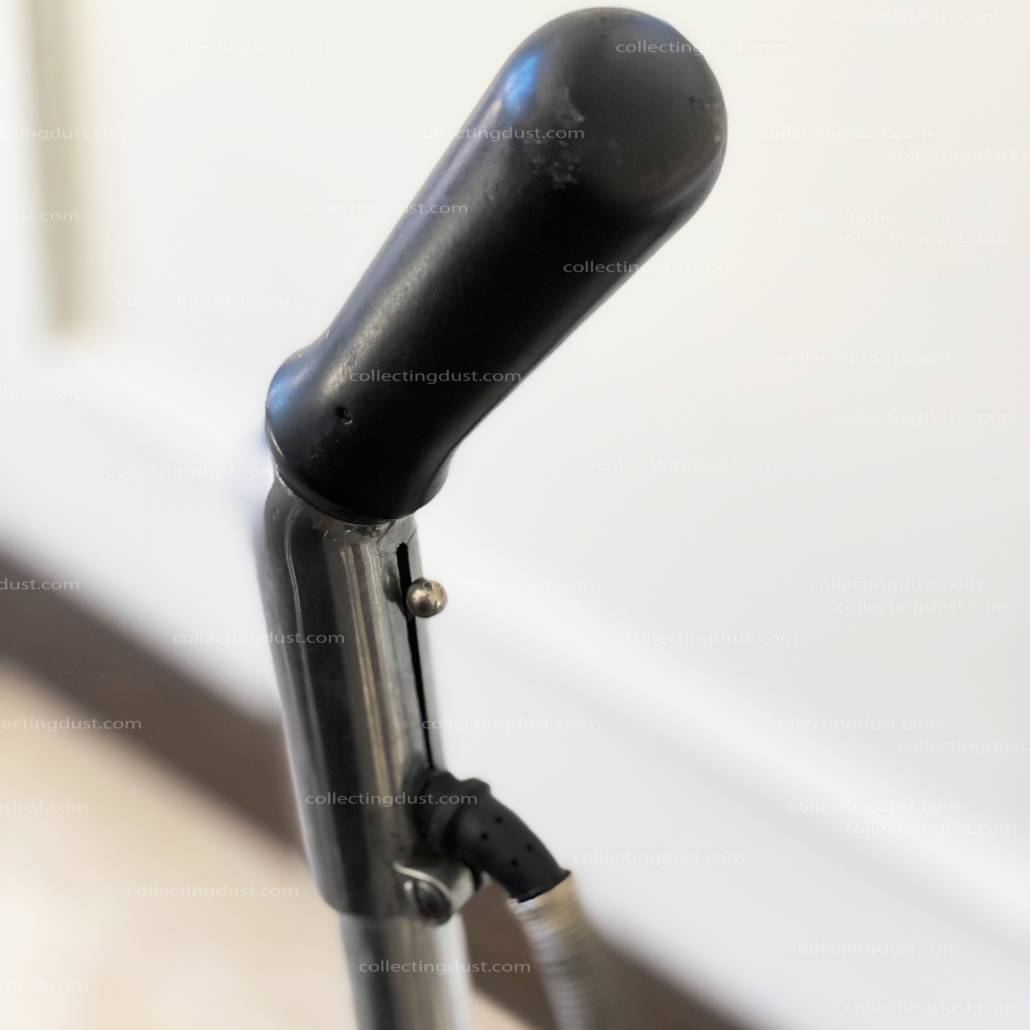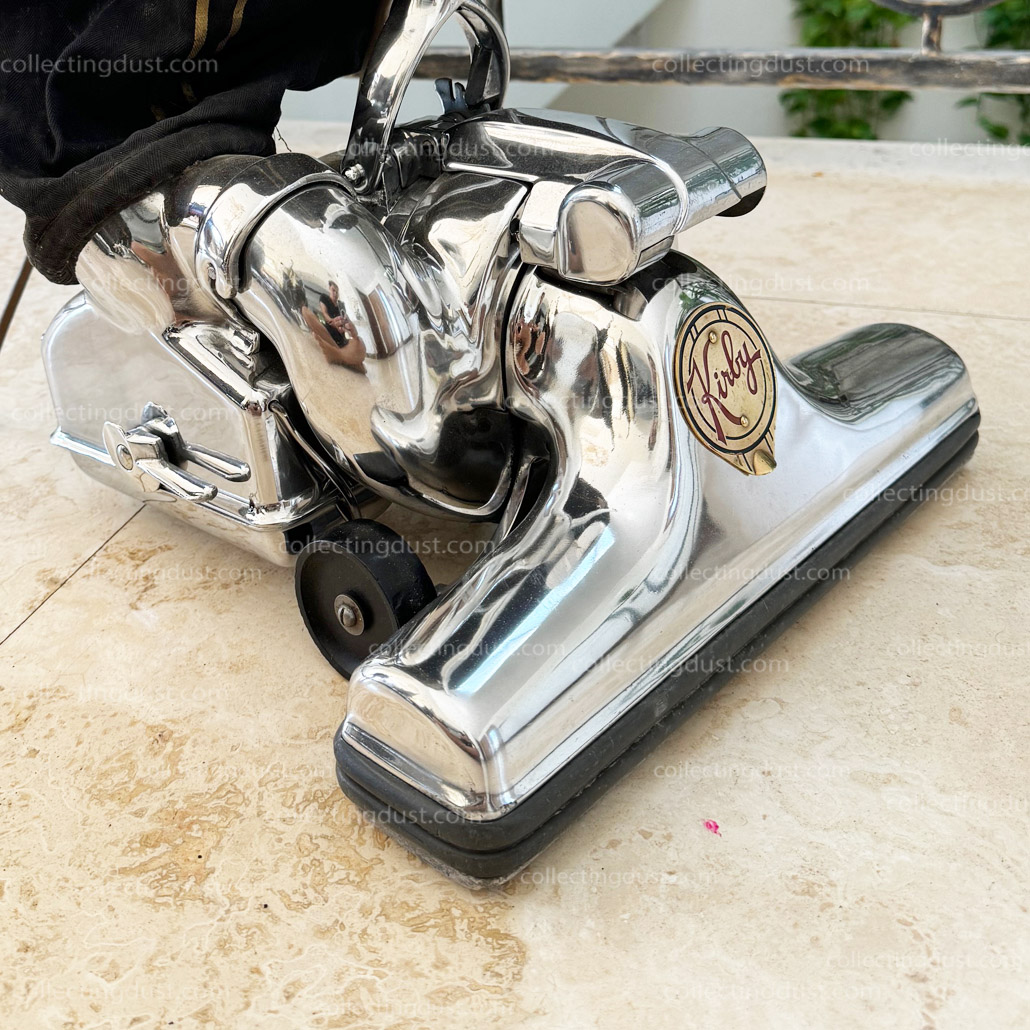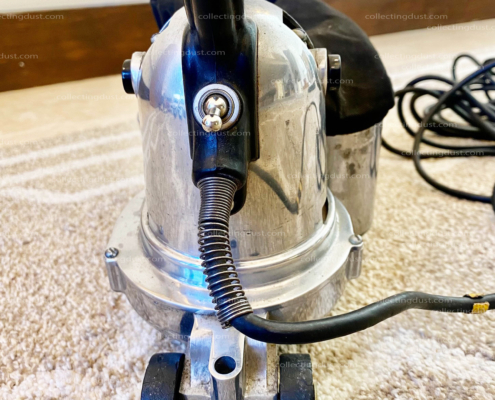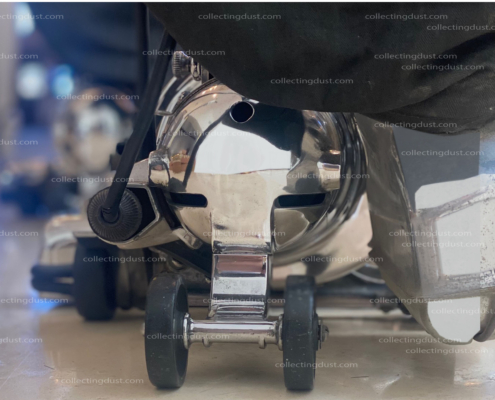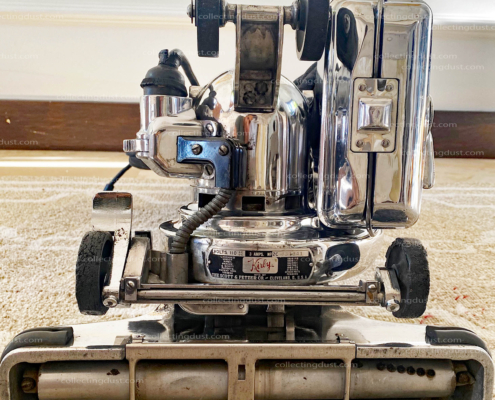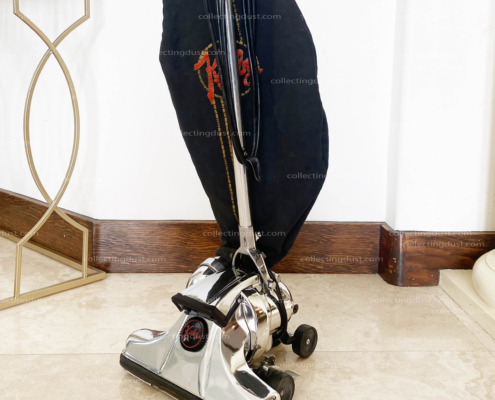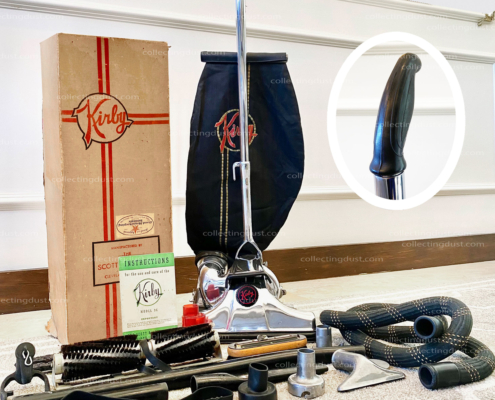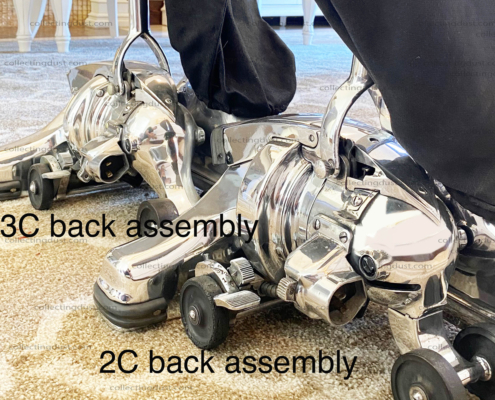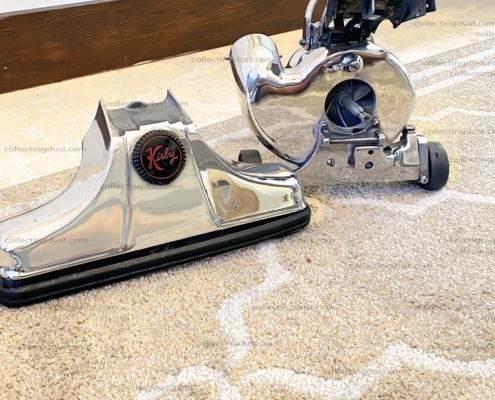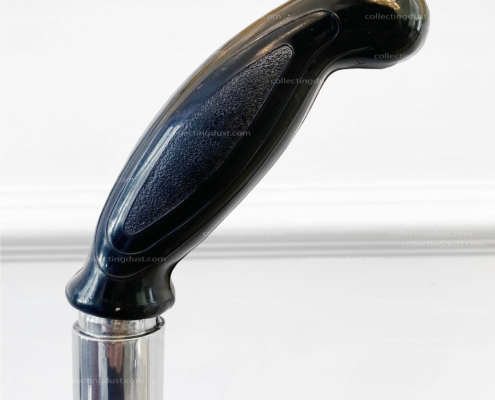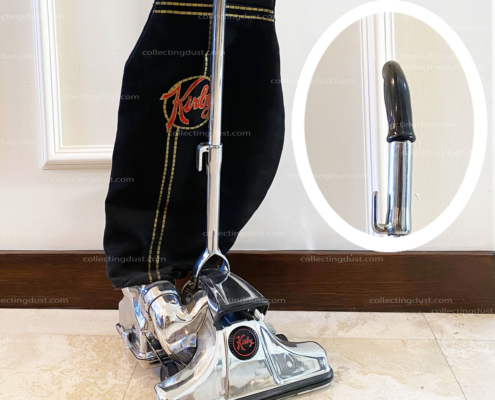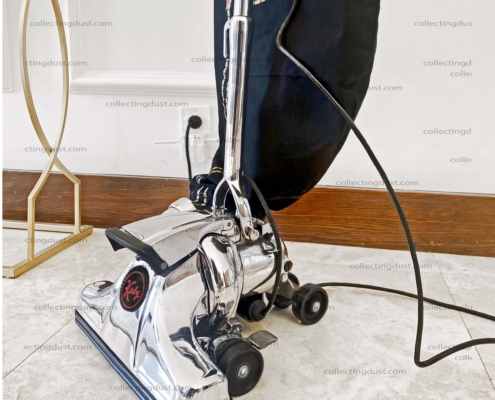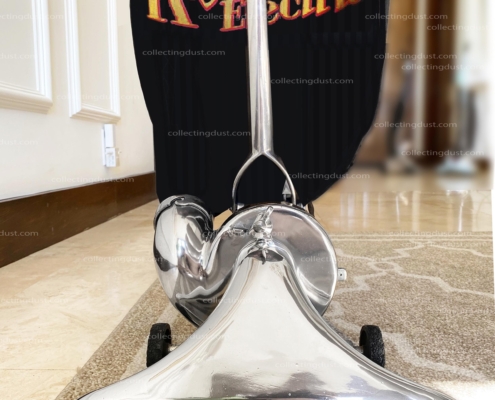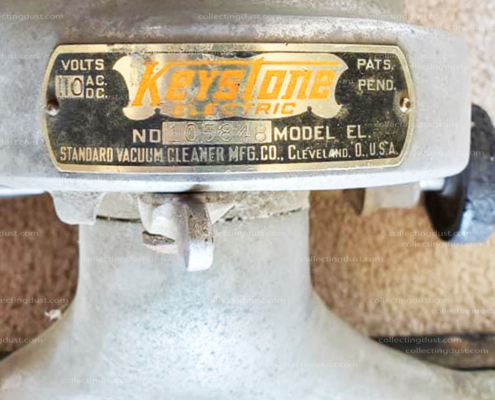Disclaimer : Kirby® is a registered trademark of Kirby Opco , LLC. I have no affiliation with either Opco ,LLC current or previous owners of Kirby® , its subsidiaries, affiliates, or related companies. I am not employed, contracted, or compensated by them in any way. I do not represent the Kirby Company in any capacity.The information provided in these pages solely reflects my personal opinions and perspectives . It should not be considered as official Kirby Company policy, practices, regulations, guidelines, or opinions. This website material is intended for informational purposes ONLY!
In 1934, the Scott & Fetzer Co.introduced their innovative belt-driven brush roll vacuum, known as the “KIRBY Model C”. This groundbreaking model not only marked a significant milestone for the company but also proudly bore the name of its brilliant inventor, Jim Kirby.
With the roll out of the Model C and R series , Kirby firmly established it’s place in the market. During the years spanning from 1934 to 1941, the company implemented comprehensive advertising strategies, effectively connecting with customers through both door-to-door sales and various retail channels.
Model C closely resembled the Scott and Fetzer sanitation system. However, it did come equipped with a brand new rug nozzle and a convenient toe-touch control system, which added to its user-friendly design.
One notable feature of the rug nozzle was a belt cover dial ( please see pic.) that was released by turning it 3/4″ to the right. it was swapped for a decorative brass cap in production . This cap, adorned with the iconic Kirby logo in striking red and black stripes, could be easily removed to attach the belt onto the motor shaft. Additionally, the rear axle of the vacuum was a separate curved metal piece securely attached to the motor housing like its predecessor the S&F Sanitation system .
*Note: The nozzle belt lifter hole in this model was a perfect circle with no notches.
The fan casing boasted a sharp edge and proudly displayed the Kirby brass model ID plate on top. The trim surrounding the nozzle was made of durable black rubber. All four wheels were the same size two rear wheels were permanently fastened to the back piece, while the front wheels were secured with screws and washers. All wheels were crafted from black vulcanized rubber.
The handle of the model C featured a sturdy metal fork, with a middle section made of painted black wood. The top of the handle was made of metal, providing a comfortable grip thanks to the black vulcanized rubber coating. The electric cord, made of resilient black rubber, was equipped with a metal clip. Unlike later models, the cord could slide freely in the clip, offering enhanced flexibility during use.
The bag of the model C was crafted from a canvas-like fabric, featuring a subtle yet elegant pattern of light and dark black vertical stripes. The bag’s painted logo consisted of a solid gold circle with two parallel solid gold stripes. The Kirby name was meticulously painted in thin red and gold lettering over the circle.
To ensure a secure seal, the top of the bag was fastened with a sturdy metal clamp, which connected to the handle via a reliable chain. The “Sani-Em-Tor” , a compact all-metal component, was smaller in size compared to later models. It proudly displayed a brass name plate indicating “Sani-Em-tor” with a patent pending status. This innovative feature was first introduced with the last model of the “Scott and Fetzer sanitation system.” The latch on this “Sani-Em-Tor” is now metal rather than painted in red like its predecessor
The model C came with a range of accessories and attachments to enhance its versatility. The hose, made of durable black fabric, featured eye-catching gold and red stripes. Two female connectors made from black rubber were conveniently placed on each side of the hose. The vacuum also included a curved black plastic wand, a short wand, a metal upholstery nozzle, a wooden upholstery brush, a black lifter grip made of fiber material, a clamp-on floor polisher (sweeper), a metal suction coupler, a spray jar with a metal top and glass jar, a metal blower coupler, a black shoulder strap, a red plastic “crystalator” with a metal cap, and an optional straight suction nozzle, which was initially introduced with the Vacuette Electric model.
For both the C and R models the vacuum and attachment box was elegantly designed in a natural brown color adorned with two horizontal and two vertical black stripes. The iconic Kirby logo in red enclosed within a black circle, proudly stood in the center, adding a touch of sophistication to the overall aesthetic.
Model R: This model featured a switch on the handle and was sold in retail shops . The R designation is shown at the end of the serial number ,whereas the C in the beginning of the serial number was concealed by an “X”. This was probably due to a last minute deal to sell in retail . This was sold in department stores ,furniture stores and vacuum shops. One such store was the Baileys Department store in Lakewood, OH .
This model was not portable and the attachments were sold separately *(some R models had the front nozzle fixed to the motor house and the optional attachments were not offered with that machine.)
The attachment box included the following attachments :
- Flexible hose
- 6’ black fibre tube
- Flat radiator tool
- Suction connection
- Blower connection
- Upholstery brush
- Upholstery nozzle
- Curved tube
- Floor polisher
- Crystalator
- Sample De-mothing Crystals
The new Kirby utility Model H hand vacuum was available for purchase both in retail stores and through door-to-door sales, was an exact replica of its predecessor, “The Vac-ue-tte utility.” However, it now boasted a stylish brass plate with black print, displaying the name “Kirby Utility” in vibrant red.
One of the standout features of the Model H was its reverse airflow capability, which allowed for the direct application of moth-repelling crystals. These crystals could be effortlessly deposited into a specialized chamber through the vacuum’s nozzle.
Weighing a mere 1.5 pounds, Model H was not only lightweight and compact but also incredibly user-friendly. Its ergonomic design made it a breeze to handle.
Furthermore, the Model H came equipped with an extra-long 20-foot cord, offering maneuverability and flexibility when navigating through various spaces. The vacuum’s bag, now a sleek plain black, no longer featured a printed logo. Interestingly, my research indicates that no patents were ever issued for this particular model, despite the “patents pending” designation on the brass plate.
The shipper box, a sturdy brown container, proudly displayed the label “Kirby Utility Model H,”in red.
( The addition of the 1 in front of the C and R is for the purpose of differentiating between the early and later models)
In 1935, Scott & Fetzer made some modifications to the original Kirby model C and introduced an updated C and R models.
The new C and R model were now exclusively produced with a headlight , same “T” shape with scroll-like edges as with the previous model . It was mounted onto the spring latch mechanism with a pin screw. The floodlight housing, made entirely of metal without any trim, clipped onto the fan casing. The 1C and 1R now had a new decorative black cap made of bakelite in a similar logo design to the brass plate with ribbed edges , a red Kirby logo in a circle and two vertical lines on each end of the circle .(please see image)
The belt cover was changed a 2nd time through the 1C /1R production and the final cap design was now printed with no vertical lines extending up and down from the outer circle , The Kirby logo in the center. The belt cover fits more securly on the C models with the 2 etched hole notches.
The rear wheels were no longer permanently fastened but instead attached with screws and washers.
Scott & Fetzer also introduced a new bag for this model,. The bag was made of a thin canvas-like material with faint black stripes,. The lettering on the bags was in gold and red or gold on gold, with the Kirby logo placed within a hollow gold circle outlined by dashed lines. There were a pair of gold stripes running down the bag from the left side and another pair going up to the top from the right side. The cuff that sealed the bag was made of metal and covered with black rubber.
The”Sani-Em-Tor” component of the new C and R models was entirely made of metal and did not have a brass name plate like with the previous model.
The attachments included with the new C and R model were the same as those included with the original models . The shipping carton for the vacuum was brown with the red Kirby logo in the middle, accompanied by two horizontal and two vertical red stripes.
Attachments box for the R was optional ,the box design was black on black checkered with a l white label and red stripe that read: “One set De-luxe attachments”
In 1937, Scott & Fetzer introduced Kirby model 2C and its retail counterpart, the 2R. The 2C featured two significant changes compared to its predecessor:
Firstly, the shape of the rug nozzle was squared and aligned with the fan casing, providing a more streamlined appearance.
Secondly, the headlight housing was larger and expanded to the sides, resembling “arms.” It was adorned with three pieces of black rubber trim, with one encircling the front bumper and two positioned inside.
On the back side of the motor, the light housing pulled back in a triangular shape to conceal the spring-latch mechanism. It was securely fastened to the motor casing with two screws.
The cord of the 2C was made of black rubber and was thicker compared to the cords used in the previous model. The 2C retained the same handle,” Sani-Em-Tor” component, accessories, and shipping carton as the C model .
Scott & Fetzer also introduced two new bags for this model, which were also used for the subsequent models. The first bag was made of a thin canvas-like material, while the second bag was made of a thicker and more durable fabric. The lettering on the bags was in gold and red, with the Kirby logo placed within a hollow gold circle outlined by dashed lines. There were a pair of gold stripes running down the bag from the left side and another pair going up to the top from the right side .
The optional open top bag had two additional parallel gold stripes going horizontally just below the cuff at the top. The cuff that sealed the bag was made of metal and covered with black rubber.The shipping carton for the vacuum was brown with the red Kirby logo in the middle, accompanied by two horizontal and two vertical red stripes
*floor suction model is now available as an optional equipment
2R: sold in department stores, same optional case with attachments as the 1R. handle switch assembly updated to accommodate a larger switch.
Models 3C and 3R, produced from 1939 to 1940, did not undergo significant changes compared to other Kirby vacuum models aside from a new 10 blade fan and the below ‘cosmetic changes”
The handle of both the 3C and 3R was made entirely of metal and featured an ornate black rubber grip. The rear axle of the 3C and 3R was no longer a separate piece but instead integrated with the motor housing
The fan casing slightly rounder with a raised notch on the top right side was assembled with screws to the motor housing. The suction coupler, which connected the hose to the vacuum, was wider and made of lightweight metal.
The shipping carton for the vacuum was brown with the red Kirby logo in the middle, accompanied by two horizontal and two vertical red stripes.
The attachments for the Model 3C and 3R remained the same as the previous model, with the exception of the floor suction nozzle. The floor suction nozzle was discontinued and no longer included as an optional extra in the Model 3C and 3R.
Aside from these changes, no other notable modifications were made to the Model 3C and 3R during their production.
* James B. Kirby continued to use Black & Decker Motors in his machines, including the Model 3C and 3R, as he found them to be trouble-free and reliable.
*Image of the 3R ID plate is courtesy of M.Balda AKA chicagomike
Kirby Models 4C and 4R featured two major modifications:
The fan casing had a rounder edge, raised notch removed and was assembled with screws to the motor housing to accommodate a larger and more powerful motor.
The ” Sani-Em-Tor”, which was responsible for trapping dust and dirt, was wider and larger in size. It still featured a metal trap door for easy disposal.
Additionally, the rear wheels of the 4C/R were now the same width as the front wheels and remained black in color.
The optional heavy-duty bag for the 4C/R was sealed on top and had two additional stripes going across the top and a grommet that attached to the hook.
The Model 4C also introduced a separate floor polisher unit that clamped to the bottom of the rug nozzle, providing an additional cleaning feature.
The rest of the attachments and accessories remained the same as with the previous model.
Early shipping carton for the vacuum was brown with the red Kirby logo in the middle, accompanied by two horizontal and two vertical red stripes. It was then updated to the maroon color box with the green logo and text that carried through the 505.
Model 4R handle and plug socket in the under motor received a facelift , the socket under the motor is now made of black plastic and the lower part of the handle is now longer with a hole in the bottom of the fork that allows the cord to be secured when plugged and not move freely as it did before.
*It’s worth noting that the Model 4R appeared on the bottom plate as “Model R” without a specific number designation and most likely was even sold alongside the early model 505 though I cannot confirm this information.
The first Model 505 was born in the aftermath of World War II in 1945. The Kirby factory, still recovering from the war’s impact, faced a scarcity of components, leading to the birth of the 505 as a faithful replica of its predecessor, the 4C. Even the early 505 manual mirrored the imagery and content of the previous 4C model.
The similarities between the 505 and the 4C are so striking that one could argue it should have been designated as the 5C.
It is important to note that the Model R has now been discontinued, making way for the 505 to be sold exclusively door to door .
The shipping carton and attachments of the early 505 remained unchanged from the 4C.
Scott and Fetzer, in collaboration with Jim Kirby, not only manufactured their own line of vacuum cleaners and private label for department stores such as “La Selle Koch” but also operated subsidiaries that produced rebranded versions of their popular models. Among these subsidiaries was The Standard Vacuum Co., which introduced the “Kwik Klean,” “Radio,” and “Thoro Cleaner” models. These non-electric vacuums closely resembled the none-electric Vacuette models B, C, and M and were sold through The Sears catalog.
In addition, The Standard Vacuum Co. offered a rebranded version called KEYSTONE for both the Vacuette Electric and the Scott and Fetzer sanitation system. The KEYSTONE model, known as the “Keystone, E,” was equivalent to the Kirby model R and was available with or without a headlight. These vacuums could be purchased individually or with optional attachments, and were exclusively sold through local dealers. There was even a utility version available, and it’s worth noting that all these models featured a switch on the handle.
The UK version of the none-electric Vacuette was referred to as the “Gem,” while the model C equivalent was known as the “National.” However, I must clarify that I have only come across pictures of these machines online and do not personally own them, so I cannot verify this information.
**Keystone reproduction images are based on pamphlets and instructional books .
The Keystone E.L was a replica of the Vacuette Model J with the switch on the handle.
This model came with a two-year guarantee against any mechanical or electrical defects, Equipped with an innovative air-cooling device, the Keystone Vacuum Model E.L remains protected from overheating, even during continuous operation over extended periods. it featured automatic lubrication and durable bronze bearings.
Attachments:
Six-foot length flexible hose , Upholstery nozzle , Upholstery brush , Tufting tool , Lifter grip , Utility coupling tube and , Blower connector and Shoulder strap.
In addition the unit came with a 20 ft. long cord.
Cost $39.50
**Images are courtesy of Chad Cunningham. Brochure is mine.


